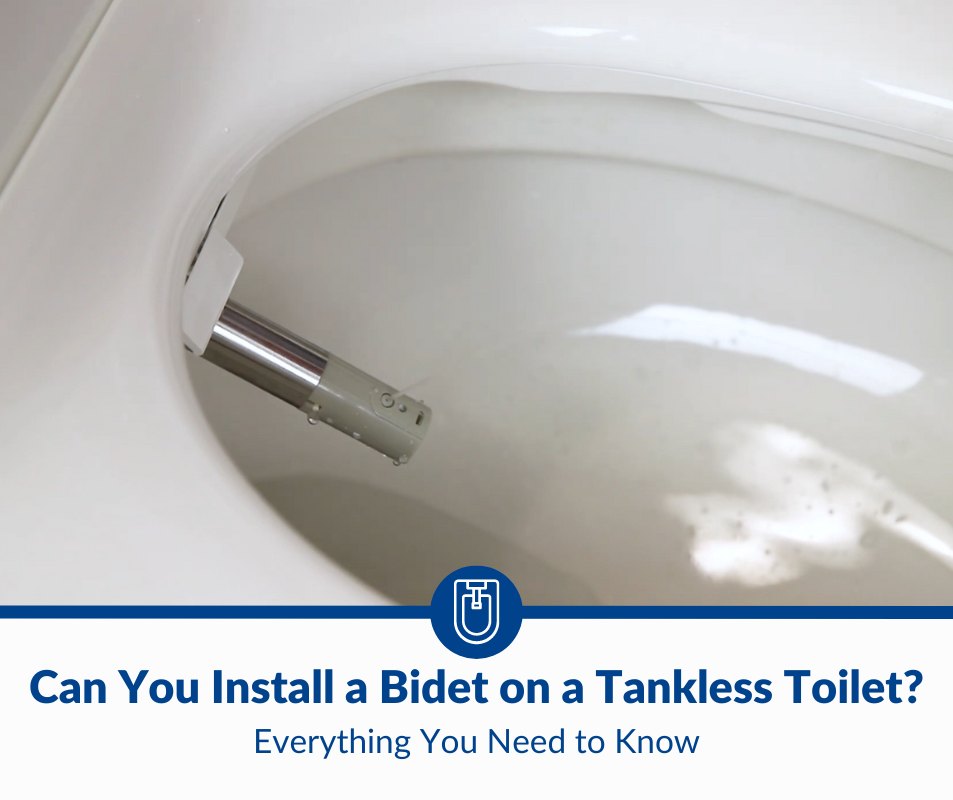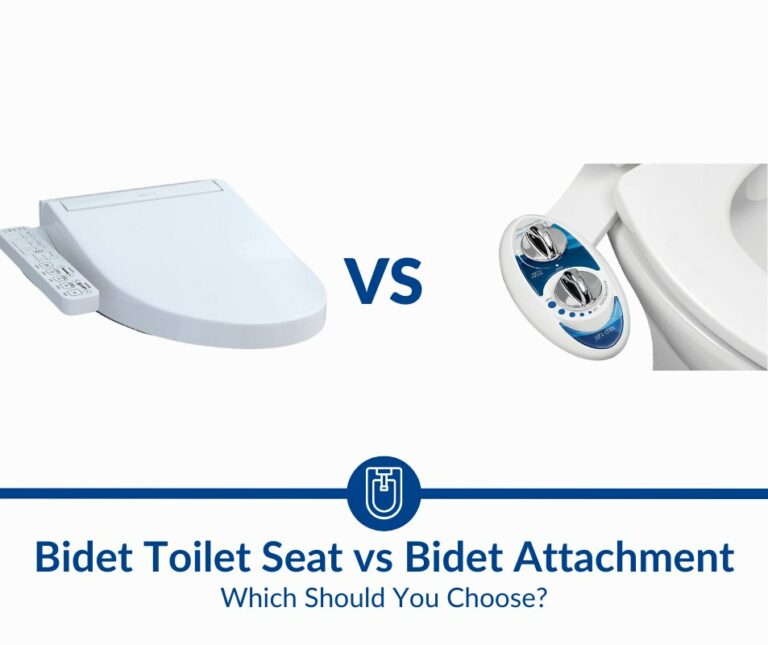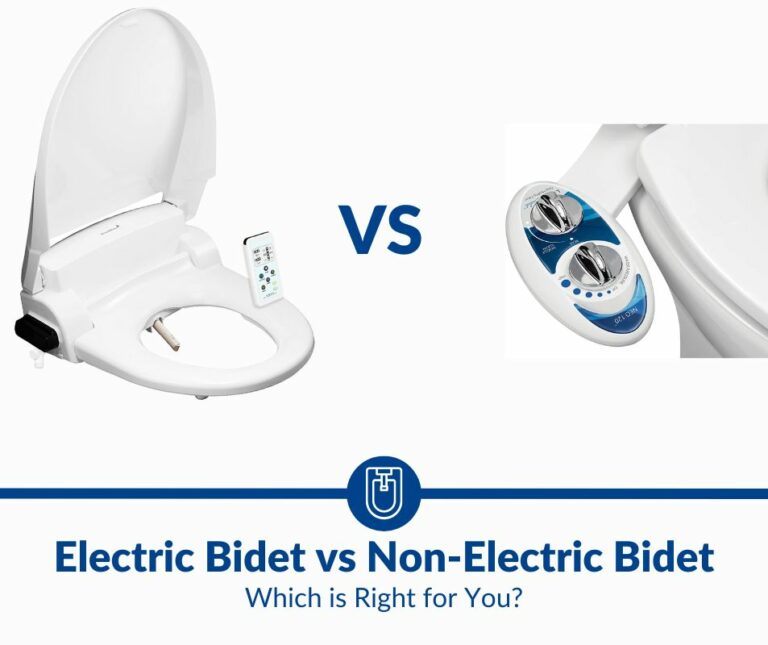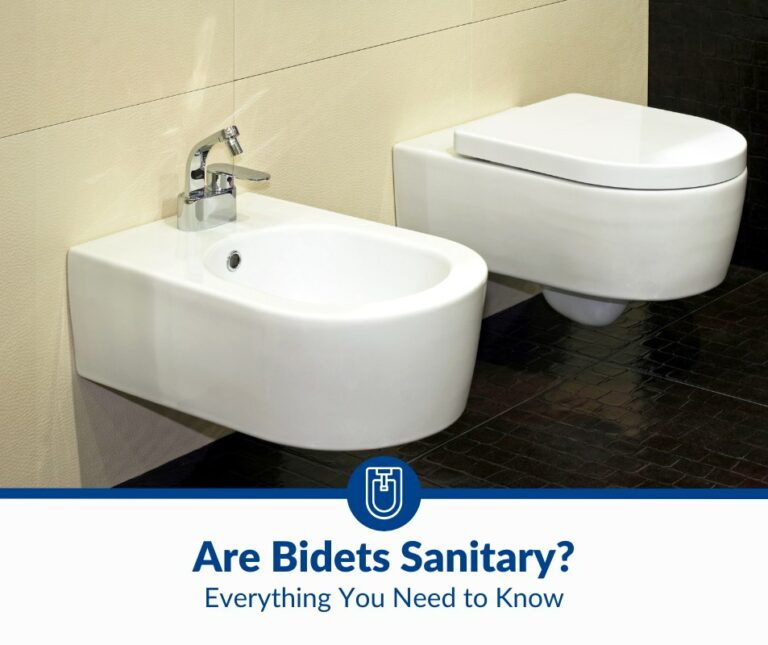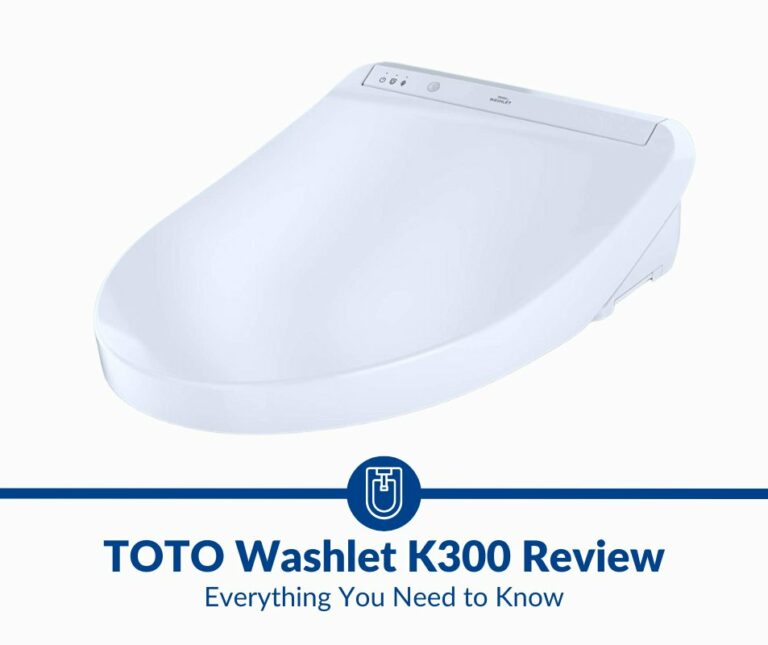Can You Install a Bidet on a Tankless Toilet?
Bidets offer some of the most sanitary cleaning experiences for toilets. That being said, some bidets rely on the toilet tank. If you have a toilet without a tank (also known as a tankless toilet), how could you also use a bidet?
You can install a bidet on a tankless toilet by connecting the bidet water inlet to the water line under the sink. You can also connect the bidet to the tankless toilet’s water inlet if the plumbing isn’t tucked in the wall. However, bidets that plug into the tank can’t be used on tankless toilets.
Throughout this post, I’ll explain how you can install a bidet on a tankless toilet with multiple methods. I’ll also let you know a few potential issues you might encounter and how you can choose the right bidet for your tankless toilet.
How To Install a Bidet on a Tankless Toilet
To install a bidet on a tankless toilet, you’ll have to decide if you want to connect the bidet to the toilet’s water supply or the sink’s water supply. You can also connect the bidet to the sink’s hot water supply if your bidet has a hot water line or a thermostat.
Consider switching off your home’s water supply if you don’t want to deal with leaks while installing the bidet. You can also cut the water supply behind the toilet or sink if they have shutoff valves.
With that done, here are the two best ways to install a bidet on a tankless toilet.
Toilet Water Line Method
If your toilet has an exposed water line, follow these steps:
- Turn off the water supply at the base of the water line. Never try to install a bidet on your toilet if the water valve is open. You can shut the valve right next to the toilet. Never flush the toilet with the valve closed. Keep a bucket or a bowl under the line because it’ll leak a little bit of water when you remove the adapter.
- Disconnect the adapter connected to the toilet, then install a T fitting or a Y fitting. Both of these fittings are shaped like the namesake letter. Most bidets include T fittings, so you might not need to buy one. It should be made of bronze or copper (aluminum is a little bit too weak for high-pressure water systems).
- Connect the bidet’s water inlet to the fitting. The hose should already be connected to the bidet. If not, connect the hose to the water inlet fitting and the bidet inlet. Add a layer of plumber’s tape to prevent it from leaking. Some companies recommend silicone sealant, so make sure you check the instructions.
- Mount the bidet attachment to the toilet. Most toilets have two mounting brackets under the seat. Remove these brackets, slide the bidet attachment over them, and seal them. Sealing will secure the bidet and prevent it from sliding around while you’re using it. Always install the bidet attachment under the seat, not above it.
- Open the water supply and test the bidet. The air will take a few seconds to get out of the lines. Keep the bidet at its lowest setting, flush the toilet to fill the lines with water, then slowly increase the bidet’s water pressure. Finally, set the bidet to whichever pressure you prefer for cleaning purposes.
Sink Water Line Method
If you want to connect your bidet to your sink’s water line, follow these steps:
- Turn off your sink’s water supply. Make sure you close the water going through the hot water line and the cold water line. These lines can drip into each other if you’re not careful. You need to close both of them, regardless of whether or not you want to install a hot water bidet.
- Install a T fitting or a Y fitting to the cold water supply (some bidets work with hot water, too. If you have this kind of bidet, connect these fittings to both water lines). As mentioned above, you’ll likely have to use plumber’s tape or silicone sealant on all three parts of each fitting to ensure a proper seal.
- Connect the bidet’s water lines to the fittings, as mentioned above. If your bidet comes with two hoses, it’s likely compatible with hot water. If you have a hot water bidet with only one hose, connect it to the hot water line. You can use the bidet’s built-in thermostat to control the water temperature.
- Connect the bidet attachment to the toilet or use a bidet seat (they’re very common with hot water bidets). Follow the instructions in the previous section to install a bidet attachment under the mounting brackets. If you have a bidet seat, remove the lid, seat, and brackets, then mount the bidet seat in its place.
- Open all of the water lines and test your bidet. Turn the thermostat up and check if it’s warm enough. You’ll have to connect your bidet to an electrical outlet if you want to use a heated seat. However, you can choose electricity or hot water lines to heat the water from the bidet nozzle.
Why Do Some Bidets Not Work With Tankless Toilets?
Some bidets don’t work with tankless toilets because they have different hoses or fittings that don’t work with the water supplies from sinks and toilets. Furthermore, many bidets connect directly to a toilet’s tank, making them obsolete for those who have tankless toilets in their bathrooms.
Here’s a look at why your bidet might not work with tankless toilets.
- Your bidet might be intended only for toilet tanks. Many bidets require a toilet tank for extra pressure, but these are becoming significantly less popular. That said, you should check how the bidet connects to your toilet and gets its water. If it needs a dedicated water line or a tank, you’re out of luck with tankless toilets.
- If your toilet doesn’t have an exposed water line and the sink isn’t nearby, you might be out of luck. Some bathrooms have doors that separate the sink from the toilet. If this is the case for your bathroom, you won’t be able to install a bidet without removing drywall to expose the water lines.
- Some bidets require electricity, which could be problematic if there’s none nearby. The vast majority of bidet attachments can work with cold water without needing electricity. However, you’ll need electrical hookups once you add higher water pressure, thermostats, heated seats, and similar amenities.
- If your toilet or sink has a low-pressure water supply, it can make a bidet very different to use. Tankless toilets require decent water pressure. Adding a bidet will worsen the pressure if you have a tankless toilet and your water pressure isn’t very good in the first place.
- Some bidets need separate tanks that aren’t a part of the toilet (this could make a tankless toilet almost pointless for the setup). Much like bidets that connect to the toilet tank, bidets with tanks are quite rare. If you get one, you’ll have to mount the tank to the wall, which means your tankless toilet has a tank again.
Thankfully, these issues are few and far between. The vast majority of people can install bidets on their tankless toilets. They’re specifically designed for multiple water supplies, so you shouldn’t worry about whether your toilet has a tank.
What Are Some Bidet Installation Issues You Might Encounter?
Installing bidets on tankless toilets is fairly simple, but there are several issues you might run into along the way.
Most of these problems are due to plumbing incompatibilities, especially since some bidets simply won’t work with tankless toilets. Additionally, you must use the right adapter materials.
Below, I’ll break down each issue you might have to deal with when installing a bidet on a tankless toilet.
- Some tankless toilets use screws to mount the seat and lid. If this is the case, you won’t be able to install a bidet attachment. You’ll have to rely on portable bidets or standalone bidets. Sometimes, you can use a bidet seat to replace the tankless toilet lid fixture.
- Many tankless toilets have their water supplies behind the drywall. Suppose the water supply is behind the drywall. You’ll have to run longer hoses or rip out the drywall, plumb the bidet, and cover it with more drywall. This process can be quite costly, and you need to know exactly where the water lines are.
- Tankless toilet seats are often flush with the toilet, meaning a bidet could bulge the seat. I suggest finding a bidet attachment that’s thinner than half an inch. This size will let you install your bidet on almost any toilet. Furthermore, choose a bidet that won’t stretch outside the toilet seat or lid.
The good news is that these issues can often be solved by choosing the right bidet. If you don’t already have a bidet, it’s best to measure your tankless toilet and weigh your options. I’ll provide step-by-step details below.
How To Choose a Bidet for a Tankless Toilet
To choose a bidet for a tankless toilet, follow these steps:
- Ensure the bidet has plumbing fittings connecting to your toilet or sink’s water supply. If your toilet has large PVC plumbing, you’ll need to get a bidet with multiple adapters. Measure the water line width on your sink or toilet line, depending on which one you hook up to your bidet.
- If you want hot water coming through the bidet, you’ll need a hot water line from your sink or an electrical outlet. That’s not an issue if you have a sink nearby. You can use a circular saw to cut a hole in the side of your sink’s cabinet for power lines or water lines. You can also slide the hoses behind the sink.
- Check if the bidet is the right dimensions for a tankless toilet. Not all toilets are the same size, nor are bidets. Make sure your bidet attachment isn’t too long, or it’ll press against the wall. It should also have holes for the mounting brackets. Check the hose length if you need to run it all the way to the sink.
- Choose your preferred pressure source for the bidet. You can decide if you want to adjust the water pressure with electricity or with a water line. Either way, you’ll need to use the water supply from your toilet or sink. If you want to use electricity on top of the water supply, you can hardware the bidet or plug it into a wall outlet.
If all else fails, you can contact the manufacturer and ask them if their bidets are compatible with tankless toilets. Speaking to the manufacturer directly is one of the best ways to know about compatibility, especially if the company sells a wide range of high-quality bidets. I also suggest going through reputable dealers rather than choosing an unknown bidet brand.
For example, the LUXE Bidet Neo 120 (available on Amazon.com) has been around for quite some time. It has a water pressure knob and a self-cleaning knob. As described above, you can plumb it directly into your tankless toilet’s water line or under the sink. It comes in blue, rose gold, and white, including the necessary fittings and adapters for installation.
What To Know Before Adding a Bidet to a Tankless Toilet
Before adding a bidet to a tankless toilet, it’s important to know that you can always remove a bidet attachment. If you choose the wrong bidet or you decide it’s not the right one for your personal preferences, you can swap it out. Furthermore, you should know that not all bidets work with all toilets.
Tech Bullion explains that some bidet attachments require permanent alterations to the property, which can be expensive. It’s also problematic if you’re living in a rental unit.
Fortunately, you can choose removable bidet attachments that you can take with you when you move. Bidets often last multiple years, so you don’t have to worry about replacing them too often.
Note: The best way to safely install a bidet is to follow the manufacturer’s guidelines. While the previously mentioned guidelines can be used with almost every bidet attachment available, it’s always worth checking the instructions provided with the unit. They also let you know which fittings and other parts you need. Following instructions can prevent leaks, worn fittings, and damaged hoses.
Should You Install a Bidet on a Tankless Toilet?
You should install a bidet on a tankless toilet if you have accessible water sources, removable toilet seat mounting brackets, and enough space between the toilet seat and the bowl.
You shouldn’t install a bidet on a tankless toilet if it doesn’t have the proper fittings. Using too many adapters will drastically reduce the water pressure.
Review this list of each of these concerns about installing bidets on tankless toilets before taking a call.
- If you have a nearby accessible water supply, I recommend getting a bidet for your tankless toilet. Bidets are extremely sanitary and excellent for saving money and toilet paper. As long as the bidet is compatible with your tankless toilet and has water access, it’s a great choice.
- If you can’t remove the toilet seat or it doesn’t line up with the bidet’s mounting holes, it’s not worth the hassle. You can choose a portable bidet if you really want one; otherwise, you’ll have to modify the toilet and drill several holes. This kind of modification ends up causing cracks and structural damage to the toilet.
- If your bidet is thin and fits between the seat and the bowl, it’s worth installing. Compatibility is incredibly important when mounting a bidet attachment under a tankless toilet seat. The last thing you want is to prop the toilet lid or seat with a bidet, making it difficult to sit on the toilet.
- You shouldn’t get a bidet for your tankless toilet if it doesn’t have wide enough fittings or inlets. You’ll have to use adapters to increase the bidet’s hose size, which greatly reduces the water pressure. This process gets rid of the whole purpose of having a bidet for cleaning purposes.
According to Bath Tubber, some tankless toilets include built-in bidets with all the features you could ask for. Having the bidet be built-in makes it much easier to have a bidet with your toilet because you don’t have to worry about making additional modifications.
Final Thoughts
You don’t have to give up your bidet’s cleanliness if you want to upgrade to a tankless toilet. There are many ways to keep your bidet in your bathroom, regardless of what kind of toilet you have. The installation will be very straightforward and quick if there’s a nearby water inlet. When in doubt, always check the manufacturer’s instructions to avoid surprises.
While bidets are extremely convenient, you might reconsider installing them if they require extensive modifications, such as having to rip out or drill the drywall. They are also bad if your water pressure is poor.

